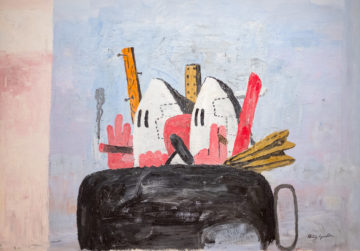Michael Prodger at The New Statesman:
 The curators have wisely given the exhibition a chronological hang which allows the viewer to see clearly just how much Guston’s art changed. His paintings of the 1930s and 1940s started in crisp-edged European modernism – with Picasso prominent – and moved into American social realism. He painted murals under the auspices of the New Deal Federal Art Project and works of social and political commentary. In Sunday Interior (1941), for example, he created a potent image of the marginalised – a young black man smoking against the background of an empty street. With Bombardment (1937), a tondo of explosions and hurtling bodies, he expressed his horror at the fascist bombing of the town of Guernica during the Spanish Civil War, the subject also of Picasso’s most celebrated work.
The curators have wisely given the exhibition a chronological hang which allows the viewer to see clearly just how much Guston’s art changed. His paintings of the 1930s and 1940s started in crisp-edged European modernism – with Picasso prominent – and moved into American social realism. He painted murals under the auspices of the New Deal Federal Art Project and works of social and political commentary. In Sunday Interior (1941), for example, he created a potent image of the marginalised – a young black man smoking against the background of an empty street. With Bombardment (1937), a tondo of explosions and hurtling bodies, he expressed his horror at the fascist bombing of the town of Guernica during the Spanish Civil War, the subject also of Picasso’s most celebrated work.
Being a painter, Guston thought, was about “fixing an image you can tolerate” and as the 1940s progressed his pictures made him increasingly itchy. “Everything seemed unsuccessful, I couldn’t continue figuration.”
more here.
